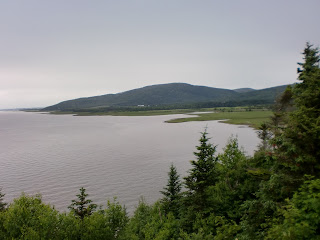June 21 -- After saying good bye to Cape Breton Island we made our way
to Halifax
along the southeast shore. Fishing is
definitely the principal means of life in this part of Nova Scotia.
Quaint fishing villages dot the rocky coast. Much of the scenery is like northern Michigan or the UP. At one point the road ended at a ferry dock –
it was not real clear on the map, so we were a bit surprised. The ferry captain said it happens all the time.
 |
| Country Harbour Ferry Rte 211 Nova Scotia |
It was a long day of driving and sight
seeing, so we were looking forward to a day of walking around Halifax on Friday.
The weather was overcast and rainy most of the time we were
on the mainland of Nova Scotia,
so we did not take so many photos. We
walked all around downtown Halifax
including the waterfront and the fortress at the Citadel. In the evening we did a mini pub crawl to
three pubs that had live music.
Unfortunately none of the featured musicians played maritime or Celtic
music, but they were all entertaining.
 |
| Historic Properties on the Waterfront in Halifax |
 |
| View of Halifax from the Citadel |
|
|
|
|
|
Saturday we left Halifax and drove along the southwest coast
to Peggy’s Cove and Lunenburg. The
landscape in the Peggy’s Cove area is different from anywhere else on the
mainland. It is a barren rocky coastline
that looks like a nuclear bomb was dropped there sometime in the last 50,000
years. It is one of those things that
you cannot capture on film.
 |
| Peggy's Cove Lighthouse |
 |
| Peggy's Cove |
From there we drove down to Lunenburg, a well
preserved 19th century town that was a shipbuilding center and home
to The Bluenose and Bluenose II, famous racing schooners (pictured on the Canadian Dime). Since the weather was unpleasant, we headed
across the mainland to our evening destination, The King George Inn Bed and
Breakfast in Annapolis Royal on the northwest
side of the mainland along the Bay of Fundy. Faith, our
innkeeper, made sure that our stay at the King George would be memorable. She upgraded our room, arranged dinner plans
for us and set up a great Victorian style breakfast before we headed out on our
way.
 |
| Guests Leaving the King George |
 |
| The King George Inn B&B Annapolis Royal Nova Scotia |
|
|
The weather was still overcast and rainy on Sunday as we
made our way from Annapolis Royal to Moncton
New Brunswick. We did spend some time identifying the
historic buildings in Annapolis Royal and driving to Port
Royal. Champlain
established the first settlement in Canada
at Port Royal in 1608 and there is a reconstruction
of the settlement on this site.
 |
| Reconstruction of Champlain's Settlement at Port Royal |































